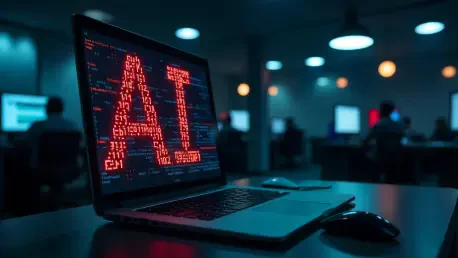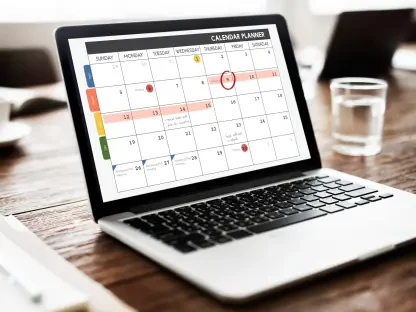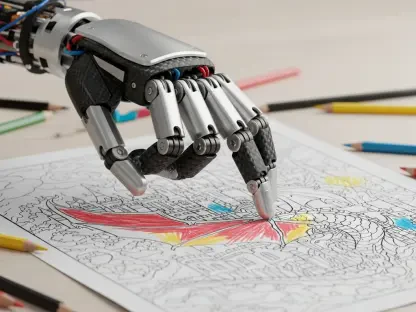This guide aims to empower aspiring creators by demonstrating how artificial intelligence can transform video production into an accessible, enjoyable process for individuals at any skill level. Imagine a world where a small business owner can craft a polished promotional video in a single afternoon, or a social media enthusiast can turn raw footage into a captivating story without ever touching complex software. With AI tools, this is no longer a distant dream but a tangible reality. Video production, once reserved for professionals with years of training, now opens its doors to everyone, thanks to intuitive platforms that handle technical hurdles. This introduction explores the profound impact of AI on breaking down barriers, setting the stage for a detailed journey through the steps and benefits of these revolutionary tools.
Transforming Creativity: The Rise of AI in Video Production
The landscape of video creation has undergone a dramatic shift with the advent of artificial intelligence, tearing down the walls that once separated hobbyists from professional results. For many, the dream of producing engaging content has been stifled by the daunting complexity of traditional editing software or the prohibitive costs of premium tools. AI steps in as a game-changer, offering user-friendly platforms that automate intricate processes, allowing creators to focus on storytelling rather than technicalities.
Accessibility lies at the heart of this transformation, as AI tools cater to a diverse audience ranging from social media influencers to small business owners and passionate narrators. These solutions eliminate the need for extensive training, presenting interfaces that feel as familiar as everyday apps. The automation of tasks like cutting clips, applying effects, and optimizing audio ensures that even beginners can achieve a polished look without grappling with jargon or steep learning curves.
Moreover, the impact of AI extends beyond mere simplification; it delivers professional-quality outputs that rival those of seasoned editors. By addressing common frustrations such as time constraints and skill gaps, these tools empower users to experiment freely and bring their unique visions to life. This democratization of video production marks a new era where creativity, not technical prowess, takes center stage for everyone eager to share their message.
Breaking Down Barriers: Why Traditional Video Tools Fall Short
Historically, video production has been an exclusive domain, largely due to the inaccessibility of conventional tools for casual creators, and many aspiring videographers have found themselves deterred by the overwhelming demands of legacy systems that prioritize expert users over beginners. This section delves into the core reasons why traditional methods have failed to serve hobbyists, paving the way for AI as a revolutionary alternative.
The financial and technical obstacles associated with older video editing platforms have long created a divide between amateurs and professionals, making it challenging for newcomers to break into the field. High-end software often comes with expensive licenses, while the hardware required to run such programs adds another layer of cost. For those just starting out, these barriers can feel insurmountable, often halting creative pursuits before they even begin.
Beyond mere affordability, the sheer complexity of these tools has alienated countless potential creators. The expectation of mastering intricate workflows and understanding specialized terminology has kept video production out of reach for many. As a result, the gap between an idea and its realization has remained wide, until AI emerged to bridge it with intuitive, cost-effective solutions.
The Complexity of Legacy Editing Software
Traditional editing software often presents a formidable challenge to newcomers through interfaces packed with unfamiliar features and dense menus. For someone without prior experience, navigating these platforms can feel like deciphering a foreign language, with terms like “keyframing” or “rendering” adding to the confusion. This steep learning curve discourages beginners from even attempting to edit their first project.
The workflows in such programs are rarely designed with ease of use in mind, requiring multiple steps for even the simplest tasks. Adjusting a clip’s timing or applying a basic filter might involve navigating several panels and settings, each with its own set of rules. This complex structure often leads to frustration, as users spend more time troubleshooting than creating.
Ultimately, the intimidating nature of legacy tools stifles the initial enthusiasm of hobbyists who simply want to tell a story through video. Without a streamlined approach, many abandon their projects, unable to reconcile their creative goals with the technical demands. AI tools, by contrast, prioritize simplicity, ensuring that such roadblocks become a thing of the past.
Financial Hurdles for Hobbyists
The economic barriers tied to professional video production tools create a significant deterrent for casual creators looking to dip their toes into content creation. High-end editing software often carries subscription fees or one-time purchase costs that are simply unaffordable for individuals working on personal or small-scale projects. These expenses can quickly add up, turning a hobby into a costly endeavor.
Beyond the software itself, additional costs for premium assets like stock footage, music libraries, and specialized plugins further strain budgets. For hobbyists without access to corporate resources, acquiring these elements legally and at full price often means sacrificing quality or scope in their work. This financial limitation restricts their ability to compete with more established creators.
Even when free or lower-cost alternatives are available, they frequently lack the robust features needed for polished results, leaving amateurs at a disadvantage. The cumulative effect of these financial challenges often forces aspiring videographers to shelve their ideas, unable to justify the investment. AI platforms, with their affordable or freemium models, offer a much-needed relief from this cycle.
Lost Creative Potential Due to Technical Limits
Technical constraints in traditional video tools often prevent hobbyists from fully realizing their artistic visions, creating a significant gap between imagination and execution. Tasks such as color correction, audio balancing, or adding dynamic effects require a level of expertise that many beginners lack, resulting in outputs that fall short of their intended impact. This limitation can be deeply discouraging.
The inability to experiment freely due to complex interfaces or insufficient resources also hampers creative growth, leaving many aspiring creators frustrated. They often find themselves stuck in a loop of trial and error, unable to achieve the seamless transitions or professional aesthetics they envision. Over time, this struggle diminishes confidence and stifles the willingness to push boundaries in storytelling.
Ultimately, the technical demands of conventional tools rob hobbyists of the joy of creation, turning a passion into a source of frustration. Countless stories remain untold as a direct result of these barriers, highlighting the urgent need for solutions that prioritize ease over expertise. AI emerges as the answer, restoring the focus to creativity rather than technical mastery.
Mastering Video Creation: A Step-by-Step Guide with AI Tools
Navigating the world of video production no longer requires years of training, thanks to AI tools that streamline every stage of the process. This section offers a clear, actionable roadmap for beginners, breaking down video creation into manageable steps. Each phase leverages intelligent features to ensure professional results with minimal effort, making the journey from concept to completion both accessible and rewarding.
The following guide is designed to cater to users of all skill levels, focusing on practical applications of AI technology. From organizing raw footage to exporting a polished final product, each step builds on the last, ensuring a cohesive workflow. By following these instructions, creators can transform their ideas into compelling videos without the traditional headaches associated with editing.
Whether the goal is to create a viral social media clip or a professional business presentation, AI tools adapt to various needs with intuitive functionality. This step-by-step approach demystifies video production, allowing hobbyists to focus on their unique perspectives rather than technical intricacies. The process outlined below serves as a foundation for crafting content that stands out in any context.
Step 1: Importing and Organizing Footage with Smart Analysis
Begin the video creation journey by uploading raw footage into an AI-powered platform, where intelligent algorithms take over the initial heavy lifting by streamlining the editing process. These systems automatically analyze the content, categorizing clips based on visual elements, audio cues, and overall quality. This smart organization provides a solid starting point, saving hours of manual sorting.
The platform’s ability to detect key moments within the footage ensures that creators can quickly identify the most impactful segments. By highlighting usable content and flagging redundant or low-quality material, AI sets up a streamlined foundation for editing. This automation eliminates the guesswork, allowing creators to focus on the narrative rather than mundane tasks.
Users can trust that this initial step lays the groundwork for a cohesive video, as the AI prioritizes clarity and relevance in its analysis, ensuring a smooth start to the creative process. With clips neatly arranged, the transition to editing becomes seamless, reducing stress for those new to the process. This efficiency marks the first significant advantage of AI over traditional methods.
Leveraging AI for Initial Clip Selection
Within the organization phase, AI scene detection plays a crucial role by filtering out unusable segments and suggesting optimal arrangements to streamline the editing process. This feature scans for changes in lighting, motion, or audio to determine natural breakpoints, ensuring that only the best content moves forward. Such precision saves time and enhances the video’s flow from the outset.
Additionally, the technology offers recommendations on how clips might best fit together based on thematic consistency or emotional impact. For instance, it might pair high-energy scenes with similar tones to maintain viewer engagement. This intelligent curation acts as a virtual assistant, guiding creators toward effective storytelling structures.
By relying on these automated selections, users gain confidence in their starting material without needing to manually review every second of footage, and the AI’s suggestions serve as a reliable blueprint that can be adjusted as needed. This ensures that the creative process begins on a strong note. This targeted approach transforms raw data into a narrative-ready format.
Step 2: Streamlining Editing with Automated Features
Once footage is organized, the next step involves editing, where AI-driven tools shine by automating complex tasks like cutting clips and smoothing transitions. These platforms suggest natural edit points based on pacing and content analysis, creating a rhythm that feels professional without requiring manual precision. This automation significantly reduces editing time.
Beyond basic cuts, AI enhances the video with intelligent recommendations for effects and filters that complement the overall tone. The system ensures that transitions between scenes are fluid, avoiding jarring shifts that can disrupt viewer immersion. Such features make the editing phase less intimidating for those unfamiliar with traditional timelines or tools.
This step empowers creators to refine their work effortlessly, as the AI handles technical details while leaving room for customization. The balance between automation and control ensures that the video reflects personal style without demanding advanced skills. As a result, editing becomes a creative exploration rather than a technical chore.
Balancing Automation with Personal Touches
While AI offers a robust starting point with its editing suggestions, adding individual flair remains essential for a unique final product. Users can tweak automated cuts or effects by adjusting timing, intensity, or style through simple drag-and-drop interfaces. This flexibility ensures that the video aligns with specific creative goals.
For example, if the AI suggests a fast-paced transition, but a slower fade feels more appropriate for the mood, making that change is often just a click away. These manual adjustments allow creators to infuse their personality into the project without needing to override complex settings. The process remains approachable, even for novices.
By using AI as a foundation and layering personal touches on top, the editing stage becomes a collaborative effort between technology and creativity. This synergy results in a video that feels both polished and authentic, bridging the gap between automated efficiency and human expression. Creators can take pride in a product that truly represents their vision.
Step 3: Enhancing Visuals with AI-Generated Assets
With the basic edit in place, the focus shifts to enhancing the video’s visual appeal using AI-generated assets like graphics, titles, and transitions. These tools can automatically create custom elements to fill gaps in the footage, such as animated intros or thematic overlays that elevate the overall presentation. This capability adds a professional sheen without extra effort.
The AI ensures that these additions integrate smoothly with existing content, avoiding the patchwork look that often plagues amateur videos. Whether it’s a sleek title card or a dynamic scene change, the technology tailors each asset to match the video’s aesthetic, maintaining a cohesive appearance. Such precision enhances viewer engagement.
This step transforms a basic video into a visually striking piece, as AI handles the design work that would otherwise require separate software or skills. Creators can experiment with different styles, knowing that the system will adapt to their choices. The result is a polished product that stands out in crowded digital spaces.
Ensuring Consistency in Visual Style
Maintaining a uniform visual style across the video is critical for professionalism, and AI tools excel at aligning generated elements with the overall tone. By analyzing the color palette, lighting, and mood of the footage, the system suggests assets that complement rather than clash with the original content. This harmony is key to a seamless viewing experience.
Users can further refine these elements by setting parameters for consistency, such as sticking to a specific font family or color scheme for all text overlays. The AI respects these preferences, ensuring that every addition feels like a natural extension of the video. Such attention to detail prevents visual discord that could distract viewers.
By prioritizing aesthetic unity, this sub-step guarantees that the final product looks intentional and refined, even if created by a beginner. The ability to achieve such consistency without manual design expertise underscores the power of AI in video production. Creators can trust that their work will maintain a professional edge throughout.
Step 4: Perfecting Audio with Smart Synchronization
Audio plays a pivotal role in video impact, and AI tools simplify this aspect by automatically aligning music, voice-overs, and sound effects with visual cues. The technology detects key moments in the footage to sync audio perfectly, ensuring that background tracks or narrations enhance rather than overpower the narrative. This synchronization creates an immersive experience.
Beyond alignment, AI adjusts audio levels across segments to prevent sudden spikes or drops that could disrupt viewing. It balances dialogue with background elements, maintaining clarity even in complex scenes. This automated refinement eliminates the need for separate audio editing software, streamlining the process significantly.
Perfecting audio through AI ensures that the video resonates emotionally with audiences, as sound design becomes an integral part of storytelling. Creators can focus on selecting tracks or recording voice-overs, confident that the technical alignment is handled. This step elevates the overall quality, making the final piece more engaging.
Avoiding Audio Clashes with AI Mixing
One common pitfall in video production is audio inconsistency, but AI mixing tools prevent issues like uneven volume or poor timing. The system analyzes each audio layer, adjusting levels to ensure that dialogue remains audible over background music or effects. This balance is crucial for maintaining viewer focus.
Additionally, AI flags potential clashes, such as overlapping sounds that might create confusion, offering solutions like fading or muting specific tracks at key points. These proactive adjustments save creators from tedious manual fixes, preserving the flow of the editing process. The result is a harmonious audio track that supports the visuals.
By leveraging AI for audio mixing, users avoid the frustration of common sound issues that can undermine an otherwise strong video. The technology acts as a safeguard, ensuring professional-grade audio without requiring specialized knowledge. This attention to detail enhances the final product’s impact on any platform.
Step 5: Exporting with One-Click Optimization
The final step in the video creation process involves exporting the finished product, and AI tools make this effortless with one-click optimization features. These platforms automatically adjust settings like resolution, bitrate, and format to suit specific destinations, whether it’s a social media site or a professional portfolio. This ensures compatibility and quality across contexts.
The optimization process also considers file size and playback performance, balancing high fidelity with practical constraints like upload limits. Creators no longer need to navigate complex export menus or risk quality loss due to incorrect settings. AI handles these details, delivering a ready-to-share video with minimal input.
This streamlined export capability marks the culmination of the AI-assisted workflow, transforming hours of potential frustration into a single, confident click. The resulting file maintains professional standards, ready to impress audiences on any device or platform. This ease of completion reinforces the accessibility of modern video production.
Testing Playback Across Multiple Contexts
Before sharing the video widely, verifying playback across various devices and platforms ensures a consistent viewer experience, and AI assists in this critical check by providing valuable insights. Many tools offer built-in previews or simulations for different environments, highlighting potential issues like aspect ratio mismatches or buffering delays. This proactive approach prevents post-upload surprises.
Creators can use these insights to make last-minute tweaks, such as adjusting compression for smoother streaming on mobile devices. The AI often suggests alternative export settings if problems are detected, ensuring the video performs well everywhere. Such thoroughness builds confidence in the final product’s reach and impact.
By incorporating this testing phase, users ensure that their work translates effectively to diverse audiences, from desktop viewers to smartphone users. The AI’s role in flagging and resolving playback issues highlights its value as a comprehensive production partner. This final touch guarantees that the video shines in any setting.
Key Takeaways: Simplifying Video Production with AI
The integration of AI into video production offers a transformative path for creators, distilling a once-complex process into an intuitive, efficient workflow. These tools break down traditional barriers, enabling hobbyists to produce professional-grade content with ease. The benefits span every stage, from initial footage analysis to final export, ensuring consistent quality without extensive training.
Some of the standout features include automated scene detection for precise clip selection, intelligent color correction for visual harmony, and one-click exports tailored for various platforms. Additionally, smart audio synchronization and AI-generated assets enhance storytelling, while built-in safeguards prevent common errors. These elements collectively redefine what’s possible for amateur videographers.
This concise summary serves as a quick reference, highlighting how AI empowers users to focus on creativity over technicality. The streamlined steps and intelligent features ensure that video production is no longer an exclusive skill but a craft accessible to all. Embracing these tools opens up endless opportunities for impactful content creation.
Beyond the Basics: The Future of AI in Video Storytelling
Artificial intelligence continues to reshape the realm of video storytelling, democratizing access to content creation on an unprecedented scale. By removing technical and financial obstacles, these tools empower individuals from all walks of life to share their narratives with global audiences. This shift fosters a richer, more diverse digital landscape where every voice has the potential to be heard.
Looking ahead, emerging trends in AI promise even greater advancements, such as real-time editing capabilities and hyper-personalized content generation based on viewer preferences. Over the next few years, from 2025 onward, expect innovations that further blur the line between amateur and professional outputs. However, challenges like maintaining originality amidst automation will require careful navigation to preserve creative authenticity.
The evolving nature of AI in video production invites creators to stay engaged with this dynamic field, exploring new possibilities as they arise. Balancing technological assistance with personal expression remains key to crafting meaningful content. As these tools advance, they continue to redefine storytelling, ensuring that creativity remains at the forefront of digital expression.
Start Creating Today: Embrace AI for Your Video Journey
Reflecting on the journey through AI-assisted video production, it became evident that barriers once deemed insurmountable had been dismantled with remarkable ease. Each step, from importing footage to exporting the final piece, has been simplified through intelligent automation, allowing creators to channel their energy into storytelling rather than technical struggles. The process has proven accessible, rewarding, and surprisingly swift for hobbyists of all backgrounds.
Looking back, the empowerment felt during this creative exploration had opened doors to professional-quality results that once seemed out of reach, making the impossible feel achievable. For those who had hesitated to start, the next step was clear: dive into an AI platform and experiment with a small project to witness the transformation firsthand. Exploring different tools and features could reveal untapped potential in personal or professional narratives.
As the digital space continues to evolve, staying curious about AI advancements has positioned creators to adapt and innovate with each new development. Taking inspiration from this guide, the focus could shift to building a portfolio of videos, each one a testament to growing confidence and skill. Sharing these stories with the world becomes the ultimate goal, made possible through the accessible power of artificial intelligence.









